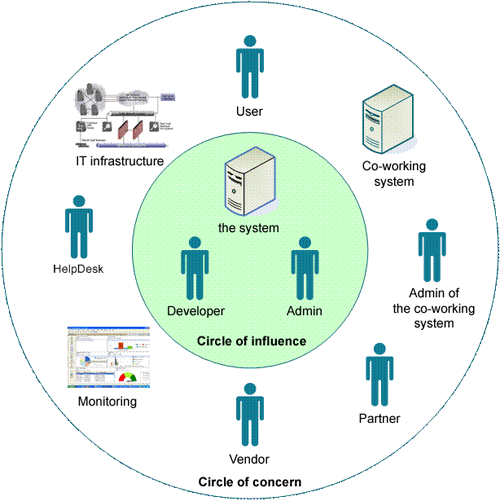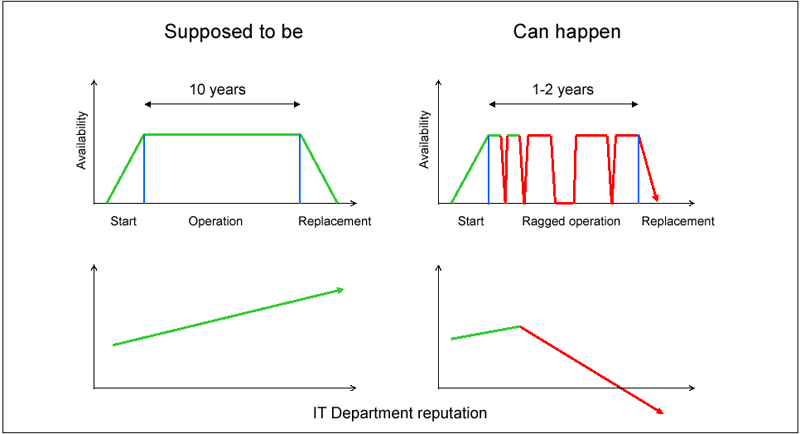Any CIO's image is tightly bound to the services' images which are provided by the IT-Department. IT-Managers have many tasks but one of the main tasks is to know his or her current rating as well as the IT-departments rating and to manage his reputation through managing information systems image.
Context
This article is oriented to CIO and IT-managers of the companies whose existence and profit depends on availability of information systems. Here is an approach to service level management for mission and business-critical corporate systems. Nevertheless this experience can be useful for the IT-managers of the companies which do not have such systems.
What does service mean?
In 1998-1999 I managed the customization and implementation of an ERP- system in Vimpelcom, a leading Russian telecom operator. The system was successfully started and operation began. And as usual, the first operating months were accompanied with lots of errors which could cause fails in accounting or warehouse operations. The company had a maintenance contract with the vendor and the company's employees had to submit defects to the vendor for fixing.
One day a big incident happened and accounting operations were paralyzed. I asked the systems administrators what they were doing for the fastest service recovering. They said they sent the bug report to the vendor and now they were just waiting for the fix. It was strange, that they were calm and satisfied with their on time sending the bug report. The same time the accounting department of a large corporation could not work. I said to them that they had enough qualification and knowledge of the systems architecture and could try to find the bug themselves and to help the vendor in fixing the bug. It appeared that they had never thought of such an approach and began investigation. They did find the bug earlier then the vendor and the service was recovered. After that case they solved the problems in a half of such cases and service level was increased significantly. Then I faced the fact that not all of IT employees knew what a good service means and how it could influence on their career.
But it was only beginning and I didn't know that reactive approach could ruin even huge IT empires.
Image of systems and image of their creators
During my career I saw ups and downs of several IT empires. My observing has shown that very modern IT departments with well trained leaders and staff could lose their rating. It looked like everybody tried to do his best but then they faced the fact that their reputation is greatly low.
Even robust IT department can lose its image in business departments' opinion. Losing reputation IT department also loses the immunity to inner an outer diseases like intrigues, low-quality staff, wrong decisions dictated from outside the IT department just because of IT-staff's low reputation.
I was concerned with the affect of falling reputation of successful at the fist glance IT departments and I began to investigate how it could happen. I came to the simple conclusion that the reputation of CIO's and IT staff's individuals inseparably linked with the image of information systems and services. It is very simple. If the rating of a system in users' opinion goes down so do the personal ratings of IT-people who develops and maintains the system, the CIO's reputation goes down as well. This link is obvious but IT people do not think of it.
Why don't we think of our image?
There are several reasons why IT people don't think of their image in the users eyes:
- We all are introverts focused on technology, not people.
- We do not care of users' opinion. We believe in our infallibility.
- We have high IQ. We see ourselves advanced and above users.
- We have reactive approach to the service level.
Yes, we, IT people, are introverts. But everything we do is dedicated to servicing the people, and IT departments' job is service. But we sometimes just don't see any human being in the user and consider them as not important for our great mission. We often know "better" then the business users, what is important for the Company. I have even heard of "IT snob" term.
As a result we make a blunder for engineers when we refuse feedback. But no system can work properly without feedback. Our main feedback is customers' and users' opinion about IT service.
Knowing nothing about users' opinion of our systems' working is the main threat for IT organization. If you don't know what the users think of you, be prepared for surprises.
Why should we manage IT systems image?
Unfortunately, IT systems' image is inclined to get worse as time goes. We all know that the good is accepted as a matter of course, but the bad is rumored ten times widely. Good work of an IT department must be PR-ed purposely. Bad service makes PR itself.
I saw many time new systems started. The fact, that the systems are operating and supporting profitable business processes, remains unnoticeable. But the fails are memorized and accumulated in the users' memory. The image of the systems is going down and the IT staff's image follows. Sometimes it is complicated to explain the link between them to IT people. Their infallibility prevents them from being successful. Why are we surprised when get less trust? Manage your systems image and your image will be blameless!
IT people often think that they do their work well and if the systems work badly and the business departments can not operate it is either trifle or objective reality.
Reactive approach
Reactive approach is a scourge of service level. The main display of proactive approach is working on "broken, let's fix" or "slow, let's optimize" principals.
Unfortunately, in spite of wide acknowledge of proactive approach the IT department's operations are often built on reactive approach. It doesn't depend neither on the staff's education or the richness of IT budget.
Another example of reactive approach is deliberate limitation of circle of influence for problems sources. There are a lot of potential failure sources: architecture, bugs, hardware, settings, co-working systems, and users training. Programmers and systems administrators often limit their circle of influence by the system they are responsible of. You can easily diagnose narrowing of circle of influence by statements like these:
"This is their system which is not working".
"That is them who don't do their job. What can I do if they don't do their work? This is unfair! This is their sector of responsibility. Why should I care?"
"The users just input wrong data".
And if we add our IT- infallibility here, the systems just don't have a chance for good operating.

|
| Fig.1 Circle of Influence
|
When we implement a new system we usually expect it to work long and happily. While the system is being created and started all of the participants are full of hope. We expect it to live in production ten years for example. But in practice it happens often that in a short time after starting the systems begins to have failures. As a rule business support systems are also evolving intensively and after new versions being installed interruptions come. And the systems image is being attacked. If the system is treated with "fail to fix" principle the commercial operating that supposed to be long and happy will turn into short and miserable. And the Development and Support departments lose their credibility.

|
| Fig.2 Systems' life cycle and IT department's reputation.
|
The reactive approach to service management can end with full loose of trust for CIO. The claims of average executives of business departments can go up the business department vertical and burst into the CIO's face on the top management meetings. The CIO's career even can be over in serious organizations whose business is based on IT. And as it was mentioned before, neither advanceness of IT department nor the CIO's previous rewords can help.
Even clever IT managers can get hostages of reactive approach of their employees to the IT-services image. No technology is involved. Only psychology is to blame.
The opposite of reactive approach is proactive one which is based on incidents prevention.
Imagine that the airplanes were treated on the "fail to fix" basis. Would you ever come inside such a plane? The conclusion is simple. The plane must be fixed before its failure! Then it will never crash.
What to do
For getting the IT organization onto a safe orbit it is necessary to instill two important things in IT staff. The first thing is client focus the second one is proactive approach to service.
If you want to focus the staff on the client you will have to develop the right attitude:
- Explain your employees their "weaknesses" in communication
- Explain why client-focus is important
- Get them from their chairs and send them to communicate with the business users
- Make the respect of users needs part of the IT culture
- Implement a regular customer satisfaction questioning
The second part of high quality service is the proactive approach to managing information systems image. To implement a proactive approach you have to discuss with your employees the sources of an instable systems work and to give them the examples of proactive behavior. To achieve the reliable systems work IT people must expand their influence farther the objects they are responsible.
For beginning
If you are running a department responsible for developing and maintaining information systems critical to your company business, consider these practices:
- Customer satisfaction survey
- Capacity and mean-time-between-failures monitoring
- Monthly incidents analysis
- Quarterly meetings with the users for getting their needs and expectations
- Regular visiting users' work places for observing and understanding their way of work
- Creating a Service Level Management function within the IT department. But do focus on attitude and responsibility, not on SLAs and other bureaucratic artifacts.
If you decided to implement proactive management of information systems' image do start with Customer Satisfaction Index. The most important thing is not to be afraid of truth. Being afraid of getting bad mark will prevent you from getting feedback and throw you away from reality and success.
All of us love the good marks, but the bad ones are more valuable for us. The bad marks give us the chance to get better.
If you are questioning 10 users you must get all 10 replies. If answering ratio is 30% treat the other 70% of not answering users as indication of real problems. If the users don't answer your email call them or walk to them. If you are afraid of the users not telling you truth, ask anybody else to inquire them.
Having got the feedback, ask your team to brainstorm for increasing user satisfaction. Do what you invented and measure user satisfaction index again. Don't forget to inform the users about your working for them.
Now during the crisis many industries reconsider value and cost of IT, quality criteria being changed. But all of us are using and will use the services of the companies critically based on IT, banks for example. The suggested approach to managing service level does not need any considerable CAPEX because it lies in attitude area. I believe this experience and ideas to be useful for building and changing an IT department oriented to high level service and great reputation of its leaders.
Vladimir Herrmann - CEO, Instream
Published in CNews от 10.01.2010


 © Instream 2005-2013
© Instream 2005-2013
